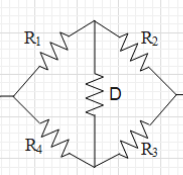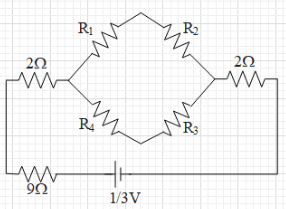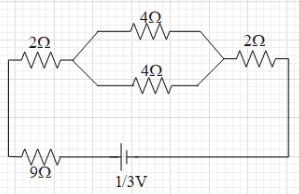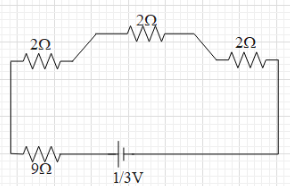Question
Question: For the given circuit find out the – 
(a) total resistance of the circuit across the battery terminals.
(b) potential difference between A and B.
Solution
First, check whether the wheatstone bridge in the given circuit is balanced. Then use the formula for the effective resistance of two resistances in series and two resistances in parallel connection to find the total resistance of the circuit. Use Ohm’s law to calculate the current in the circuit.
Formula used:
When two resistances are in series connection, the equivalent resistance of the two is given as Req=R1+R2.
When two resistances are in parallel connection the equivalent resistance of the two are given as Req=R1+R2R1R2
ΔV=iReq,
where i is the current passing through the battery and ΔV is the potential difference produced by the battery.
Complete step by step answer:
(a) In the given figure, we can see that the circuit consists of a Wheatstone bridge.

If the wheatstone bridge is balanced then the current in the bridge resistance (D) will be zero.
The condition for a wheatstone bridge to be balanced is that R2R1=R4R3.
In this case, R1=R2=R3=R4=2Ω.
Then this means that R2R1=22=R4R3=1.
Therefore, the wheatstone bridge is balanced. This means that is no current flowing in the vertical resistance of 2Ω. Therefore, it can be removed out of the circuit.

Now, we can see that both the pairs of 2Ω resistances are series connections.
When two resistances are in series connection, the equivalent resistance of the two is given as Req=R1+R2.
Therefore, equivalent resistance of both the pairs is equal to 2+2=4Ω.

Now, the two 4Ω resistances are parallel connections. When two resistances are in parallel connection the equivalent resistance of the two are given as Req=R1+R2R1R2.
Therefore, the equivalent resistance of these two is 4+4(4)(4)=2Ω.

Now, we can see that three 2Ω and one 9Ω are in series connection. Therefore, the equivalent resistance of the circuit is Req=2+2+2+9=15Ω.
(b) From Ohm’s law, we know that ΔV=iReq, where i is the current passing through the battery and ΔV is the potential difference produced by the battery.
It is given that ΔV=31V and we found that Req=15Ω.
⇒31=i(15)
⇒i=451A.
This current i current is passing through the resistance of 9Ω. Therefore, the potential difference across this resistance is ΔV′=451×9=51=0.2V
The potential difference between points A and B can be written as VA−VB=ΔV−ΔV′.
⇒VA−VB=31−51 ∴VA−VB=152V.
Note: There is always a drop in potential when we go from one end of a resistance to the other end, in the direction of the flow of the current. That is why when we go from point B to point A, first there is an increase in potential (due to the battery) and then there is decrease in the potential when we cross the resistance.
